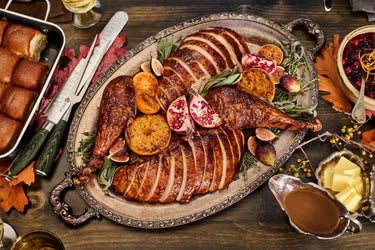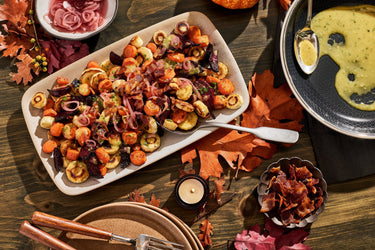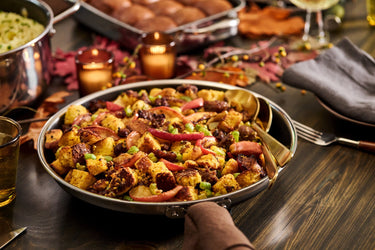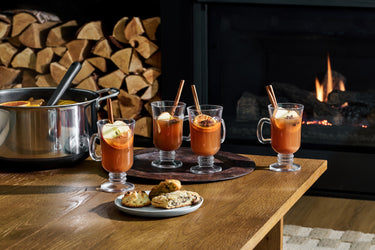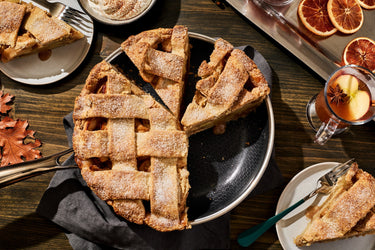To Brine, or Not to Brine (Is It Still a Question?)
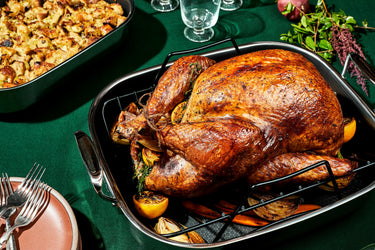
While there are many topics we prefer to avoid at the Thanksgiving table, there’s one discussion we’re happy to engage in with even the most eccentric uncle: to brine, or not to brine, the turkey.
The reason this technique trends every November is because tradition compels us to cook large birds that are prone to blandness–thanks to commercial poultry production–and have a tendency to dry out when cooked. So pass the salt and let’s dig in, because we have opinions, man. And while our opinions are simple and steadfast–“Brining makes turkey taste better, so do it!”–there’s room in this debate for nuance. TLDR: There’s more than one way to brine a bird.
WHAT IS BRINING?
Brining is the process of seasoning uncooked food (in this case, turkey) with salt in order to improve its flavor and moisture content, ultimately leading to a better-tasting outcome. An animal’s muscles, or “meat,” work like a sponge, holding moisture and contracting when heated, which squeezes out some of that moisture. But when salt comes into contact with muscle and is given enough time, it dissolves proteins and relaxes muscle fibers, which traps moisture and prevents the muscle from contracting as much. The result: juicier, tastier meat.
How you deliver salt into the meat is where the real debate begins.
THE CASE AGAINST BRINING
Before we get into the whys and hows of brining, let’s look at when you don’t need the step. Many commercial turkeys are labeled “self-basting” or “injected,” which means they’ve already been pumped full of a brine-like solution of water, salt, and other flavor-enhancing additives. These birds don’t need any more help to cook up plump and juicy, so you can skip the brining step. However, these mass-farmed birds are bred more for voluptuousness than flavor—so they won’t be your tastiest option.

Turkeys labeled “kosher” have been salted as part of their highly specific butchering process. This will yield similar results to dry-brined turkeys (more on this technique to come). They don’t need any more brining, though some cooks like to do a secondary brining at home, because the koshering process doesn’t always season the bird as thoroughly as possible.
With either style of turkey, you’re ceding the pre-seasoning step to a stranger, which is why we prefer to buy “natural,” “organic,” and/or “heritage-breed” turkeys, which will have been minimally processed, leaving us in full control of the seasoning process.
THE CASE FOR WET BRINING
Not long ago, the wet brine—a solution of water, salt, and sometimes with other flavorings—was all the rage during the Thanksgiving media cycle. We were instructed to immerse our turkeys in tubs of salted water and other multi-ingredient concoctions with the promise of thunderous applause at the Thanksgiving table.
However, we soon learned a few things about wet brines that made us rethink the balance of effort and reward. While it’s true that wet-brined turkeys emerge from the oven juicy and well-seasoned, the process makes it near-impossible to achieve the crackling crispy skin that we covet. What’s more, all of that extra water doesn’t taste like much; even if your brine is infused with herbs and spices, none of that flavor really makes it into the meat. And finding a vessel large enough to hold your turkey and its brine–and keep it cold!–usually means removing a shelf or two from your refrigerator at a time when you need all the space you can get.
There is a perfect time for wet brines, though: If you’ve found yourself with a fully or partially frozen turkey a day or two before Thanksgiving, wet brining is a great double-duty method for simultaneously thawing and seasoning the turkey. All you need to do is dissolve 1 cup kosher salt per gallon of water (a whisk will do the trick; there’s no need to boil and chill your brine) and submerge the bird in a food-safe bag or container.
But in almost any other situation we’re simply going to reach for some salt, which leads us to…
THE CASE FOR DRY BRINING
Dry-brining is our strongly preferred method for achieving a well-seasoned, crispy-skinned turkey that doesn’t dry out when it’s roasted. It’s also the easiest way to brine a bird (and almost any meat you plan to cook).
The term “dry brine” is a bit misleading, actually. As soon as salt comes into contact with meat, it begins to pull moisture out of the muscle and onto the surface, which in turn dissolves the salt and becomes a concentrated wet brine that gets reabsorbed into the meat. This process takes some time to complete; simply salting a turkey right before roasting it will have the opposite effect you’re going after.

Here’s how to do it right:
- Set a wire rack inside a large baking sheet (or our large roasting pan) and place the turkey on top. This will allow air to circulate around the turkey, rather than have it sit in a puddle of juice.
- Pat the outside of the turkey dry with paper towels.
- Grab some kosher salt (we prefer Diamond Crystal brand for its large, easy-to-grab crystals, but any brand will do here). Some folks don’t measure salt when dry-brining a turkey, but you’ll want to use at least 1 teaspoon per pound of bird. At this point, you can add additional dried herbs, spices, and (trust us) sugar to the salt; see our Thanksgiving turkey recipe for ideas.
- Grab a large pinch of salt (or dry brine mixture) and start sprinkling it over the turkey. Hold your hand high above the bird so the salt showers down evenly. Make sure you get into all of the joints and skin folds. Season the cavity generously as well. If your dry brine includes ingredients other than salt, gently separate the skin from the breast and tops of the legs and sprinkle some seasoning in there.
- Refrigerate the turkey, uncovered, for at least 12 hours and up to 3 days.
- Because salt will dry out the turkey skin, it’ll toughen up as it rests in the refrigerator. It’s a good idea to rub the skin with oil before roasting, or baste it with butter as it cooks, to achieve top turkey.
There you go! High and dry–and brined–in time for T Day.
